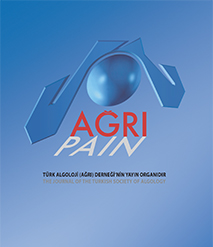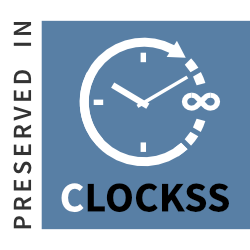Quick Search
Volume: 12 Issue: 2 - 2000
| YAYIN KURALLARI / GUIDELINES FOR PUBLICATION | |
| 1. | Guidelines for Publication Page 6 Abstract |
| YAYIN KURULU / EDITORIAL BOARD | |
| 2. | Editorial Board Page 7 Abstract |
| EDITÖRDEN / EDITORIAL | |
| 3. | Editorial Page 8 Abstract |
| 4. | Radiofrequency thermocoagulation in pain treatment M. Mehta, R. J. Stolker Pages 9 - 22 During the last decade there have been considerable advances in the understanding and treatment of pain. In particular we have learnt that pain must be treated swiftly and effectively to prevent the development of chronic pain. The physiological mechanisms created by the original injury or disease progress centrally, irrespective of what happens at the periphery. This central state is often not ameliorated by nerve block or severance of the afferent nervous pathways. Recent developments in pain therapy have consisted of new drugs, electrostimulation, psychotherapy and Pain Management Programmes. Radiofrequency procedures are being increasingly recognized as an accurate and controlled form of nerve block. Its advantages and disadvantages, in comparison with other pain treatments available are discussed. Indications for use and brief descriptions of the conditions, which can be treated in this way, are also included in this treatise. The complexities of technique are not as great, as might appear on first acquaintance, and the expertise required can be acquired by anyone familiar with the practice of regional analgesia. Patience, diligence and study are necessary for success, just as in any other branch of medicine. Finally there are exciting prospects for future developments, which could make radiofrequency procedures available for a wider range of pain problems than that at present. |
| 5. | A comparison of analgesic effect of intraarticular ropivacaine with bupivacaine following knee arthroscopy Z. Eti, C. Elmas, Y. Elmas Pages 23 - 25 The aim of this study was to compare the analgesic effect of intraarticular ropivacaine with bupivacaine following knee arthroscopy. 30 patients, aged between 20-60 years and undergoing elective knee arthroscopy were enrolled into the study protocol. A standardized general anesthesia including 5 mg/kg thiopental-sodium, 0.1 mg/kg vecuronium-bromide i.v. and 1 MAC sevoflurane with 66 % N2O in oxygen was administered to all patients. At the end of surgery the patients were randomly assigned into two groups (n=15). Group I received 20 ml 0.75 % ropivacaine and group II received 20 ml 0.5 % bupivacaine intraarticularly. Pain scores with Visual Analogue Scale at 1., 2., 4., 6., 12., 24. hours postoperatively, time to the first analgesic requirement and side effects were recorded. There were no significant difference in the postoperative pain scores of the patients between groups. The first analgesic requirement times were not statistically different (391.66 ± 81.7 min in group I and 444.16 ± 64.8 min in group II). 10 patients in group I (66 %) and 5 patients in group II (33 %) needed no additional analgesic during 24 hours (p>0.05). No side effect was observed in any patient. We concluded that intraarticular 20 ml 0.75 % ropivacaine provides effective analgesia comparable to that provided by 20 ml 0.5 % bupivacaine. |
| 6. | Intradiscal radiofrequency thermocoagulation in discogenic pain S. Erdine, G. K. Talu Pages 26 - 29 The lumbar intervertebral discs are one of the major origins of low back pain. Medical therapy, intradiscal procedures and surgery are the treatment modalities in discogenic low back pain. Recently radiofrequency denervation therapy has been used in discogenic pain. We have evaluated the efficacy and complications of application of radiofrequency in discogenic pain. 25 patients who were admitted to the outpatient clinic of Algology Department, diagnosed as discogenic pain were hospitalized for provacative test and if responded positively application of radiofrequency. Under surgical conditions and fluoroscopic guidance provocative test was applied by injection of 2ml of (iohexol and 1 % lidocaine) solution into the related disc. When the response was positive, a 80 degrees 6 minutes lesion was made. The VAS values were recorded before the procedure (VAS0), 24 h after the procedure (VAS1), 8 weeks after the procedure (VAS2). At the end of the 2nd month the patients were found to be 52 % well. No complications were observed due to the technique. We have concluded that application of RFTC in discogenic pain is an effective and safe method when conservative treatment modalities fail. |
| 7. | The effects of capsaicin in phantom limb pain A. S. Ateşalp, Y. Özkan, M. Kömürcü, K. Erler, A. Işımer, E. Gür Pages 30 - 33 The mechanism of phantom limb pain and treatment modalities have been well-documented, but some problems have not been clarified yet. No single modality has had universal success. 24 patients who have recent traumatic amputation were treated at Department of Orthopaedics and Traumatology of Gülhane Military Medical Academy. The study was done in a double-blind fashion. In this study the effect of capsaicin, a topically applied vanillyl alkaloid, was investigated. According to the statistical results, capsaicin may be used as an alternative treatment for the phantom limb pain. |
| EDITORIAL | |
| 8. | The comparison of two different PCA dose regimens after total knee and hip replacement Türkay Çakan, A. Alptekin, A. Ceyhan, M. Bababalım, R. Çetinbaş, N. Ünal Pages 34 - 42 We compared the efficacy of two different i.v. PCA dose regimens in 47 patient from ASA I-III who underwent total knee and hip replacement. The patient were randomly allocated into two groups. In the postoperative period 23 patients in the bolus group (Group 1) were received 1 mg bolus morphine HCI with 5 min. lock-out interval. 24 patients in bolus + 0.3-0.5 mg. hr.-1 basal infusion group (Group 2) were received 1 mg bolus + 0.3-0.5 mg. hr.4 basal infusion with 5 min lock-out interval. Hemodynamic and respiratory parameters. pain scores. total morphine consumption and side effect were evaluated after loading doses and at 6th. 12th. 18th and 24th hours. The pain scores in Group 2 were significantly lower than Group 1 at 18th and 24th hour (p<0.001. p<0.005). The arterial blood pressure and respiratory rates were decreased significantly after PCA (p<0.01, p<0.001) but hypotension or respiratory depression were not observed in groups. No significant differences were observed between the groups according to side effects. Knee replacement patients who were in Group 2 had significantly lower pain scores than the patients in Group 1 at 18th and 24th hours postoperatively (p<0.005, p<0.05). As a result in hip replacement patients. PCA bolus is sufficient in pain relief but adding a basal infusion to i.v. PCA when compared with PCA bolus alone is more effective and reliable in knee replacement patients without any side effect. |
| 9. | Prevention of propofol injection pain: the effectiveness of tramadol pretreatment H. Kürşad Pages 43 - 47 Propofol is a popular intravenous anesthetic induction agent, and pain on injection of propofol is a common problem. The purpose of this study was to compare the effects of pretreatment with two different dozes of tramadol and lidocaine mixed with propofol on incidence and severity of the pain produced by intravenous injection of propofol. We conducted a prospective, randomized, double-blind trial on eighty patients undergoing elective surgery. Group L, lidocaine 20 mg added to 180 mg propofol; Group T50, tramadol 50 mg 10 minutes prior to propofol; Group T100, tramadol 100 mg 10 minutes prior to propofol; Group P, plecebo (normal saline). The indicence of pain in Group P was 75 %. Group T100 and Group L had a significantly lower incidence of pain than Group P (p<0.05). There was no significant difference in the incidence of pain between the Group P and T50 (75 % and 50 %, respectively). Fourty-nine percent of the patients (18/37) who experienced pain at induction had recall of that pain in the recovery room (10 patients in Group P, 5 patients in Group T50 and 3 patients in Group T100). In Group L, none of the patients had recall of that pain in the recovery room. There was significant difference in the recall of that pain in the recovery room among Group P and other groups (p<0.0001). In conclusion, we have shown that pretreatment with tramadol 100 mg is as effective as lidocaine mixed with propofol in reducing the incidence and severity of pain during injection of propofol. But pretreatment with tramadol 50 mg is less effective than other treatments methods. |
| 10. | Cholecystectomy under local anesthesia in severe rheumatoid arthritis O. N. Aydın, H. Erpek, M. Polatlı, F. Ünal, Ş. Boylu, O. Çıldağ Pages 48 - 49 Abstract |
| ABSTRACTS | |
| 11. | Abstracts Pages 50 - 52 Abstract |
| KITAP TANITIMI | |
| 12. | Kitap tanıtımı Page 53 Abstract |
| EDITÖRE MEKTUP | |
| 13. | Editöre mektup Page 54 Abstract |
| ULUSLARARASI TOPLANTI TAKVIMI | |
| 14. | Uluslararası toplantı takvimi Page 55 Abstract |





